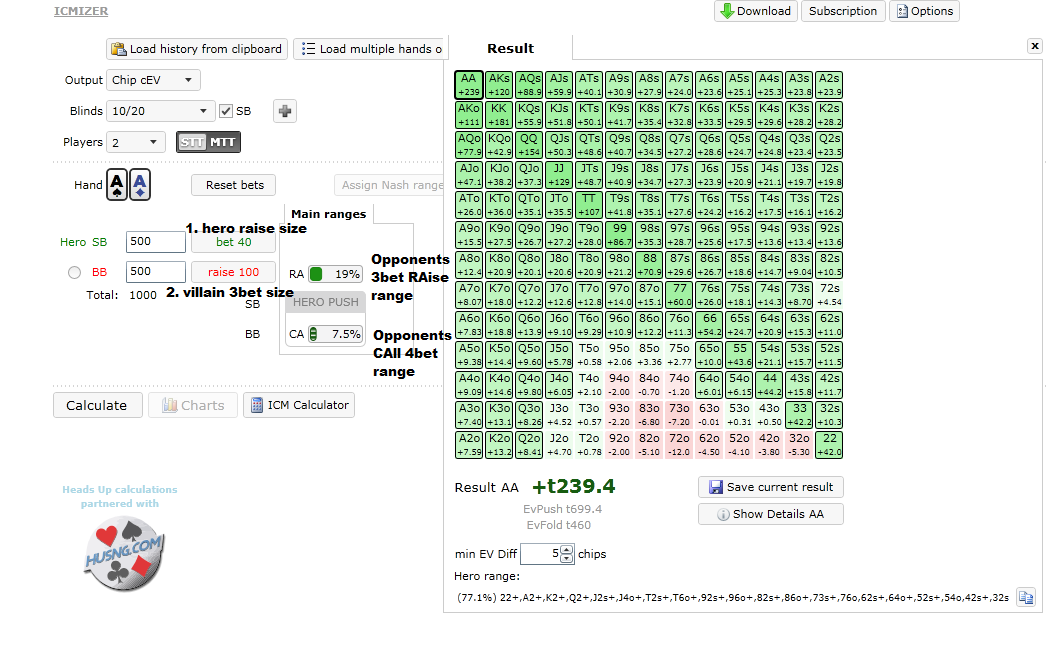How to 4bet guide: Calculate 4bet all-in range vs 3bet raise
by Q.
4bet and 3bet are powerful, expensive and difficult tools in poker player arsenal. This article goes into detail about analyzing 4bet scenarios with ICMIZER.
When we are playing tournament poker in SNG or MTT often our 4bet and 3bet resteals only make sense with all-in bet, making them technically a push or fold decision.
ICMIZER is designed to help you solve difficult push fold decisions and it now supports 4bet scenario too. Up until now you could analyze how you can 3bet opponent who makes a raise before you, an article with a heads up 3bet example is available here: notice that for normal, non heads up game you just add additional players but everything remains the same in terms of input/output.
4bet by definition is our reraise after opponent makes a 3bet raise into us preflop after we raise. Since our ICM calculator is about preflop decisions only, 4bet sizing is always an all-in bet so when you contemplate a 4bet, you are comparing 2 alternatives: you fold and opponent takes down your raise size, or you shove all-in and he/she may call you with a part of his/her 3bet range.
To analyze a 4bet scenario ICMIZER will need the following:
- your initial raise size
- opponents 3bet size
- opponents 3bet range
- opponents range of hands that he/she will call your 4bet all-in (part of 3bet range or entire 3bet range in extreme case)
Notice that just like in 3bet analysis, 4bet is pretty much the same, only real difference is that in 4 bet spot it is hero who is seating before villain and in 3bet spot hero is sitting behind raiser.
You will also need to supply correct payout structure if you are playing usual poker tournament where ICM is applied or select chipEV output if you just want to analyze MTT or heads up poker 4 bet hand.
Notice that ICMIZER takes into account so called card removal effect. That means that after you provide two ranges for your opponent, RA range – one he/she 3bets you with and CA call range, which is a part of 3bet range that he/she actually calls your 4bet with ICMIZER will take your hand into account when it will calculate probability of him actually folding or calling your 4bet.
Also for obvious reasons CA range cannot include hands that weren’t present in original 3bet range, because opponent can only call you with hands, that were in a range that he/she 3bet you with, so it is a subset of raise range. This is the same as setting up 3bet scenario in ICMIZER.
So if you hold an ace in your hand and opponent 3 bets reasonable tight range, and calls even tighter, with a part of that range which is weighted towards strong aces hands your ace in your hand helps you to maximize fold equity. Because you hold that ace, it is less likely that opponent actually will happen to have a call-part of his/her 3bet range, making him fold more often, than if you for example happen to hold Deuce Three off-suit.
On the following screenshot you can see a 4 bet calculation scenario with result display, which shows push expected value difference for all possible hero pocket hands.

Notice that in order to edit hero raise size and opponents 3 bet size you need to click on button, which has text about bet size written on it. On the screenshot those are [bet 40] and [raise 100] buttons. I found out that some users had troubles understanding how to edit bet sizes for players so I hope it will be clear after this article.
Also if you are curious about actual 4 bet call probability you can always click on the [Show details AA] (or any hand for that matter) button and see exact probabilities of call or fold scenarios with card removal effect taken into account.
You may also find a related article about 3 bet resteals interesting: analyzing 3bet resteal in heads up sng.
Please feel free to ask questions about unclear moments in comments.